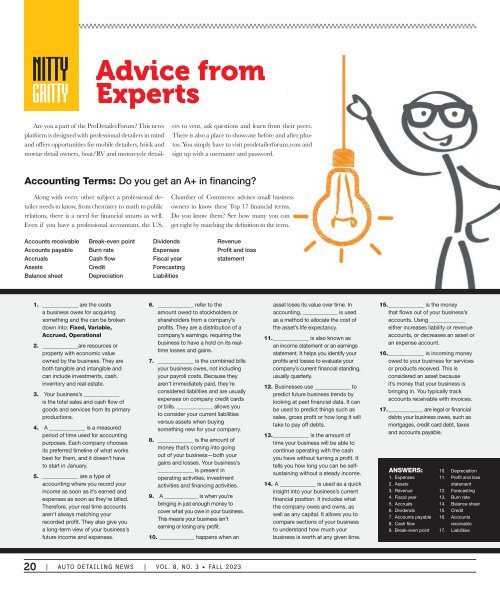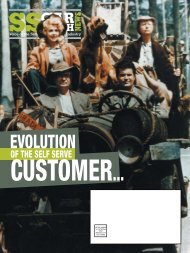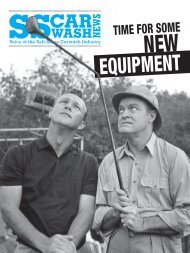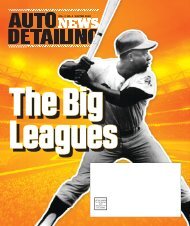You also want an ePaper? Increase the reach of your titles
YUMPU automatically turns print PDFs into web optimized ePapers that Google loves.
NITTY<br />
GRITTY<br />
Advice from<br />
Experts<br />
Are you a part of the ProDetailerForum? This news<br />
platform is designed with professional detailers in mind<br />
and offers opportunities for mobile detailers, brick and<br />
mortar detail owners, boat/RV and motorcycle detailers<br />
to vent, ask questions and learn from their peers.<br />
There is also a place to showcase before and after photos.<br />
You simply have to visit prodetailerforum.com and<br />
sign up with a username and password.<br />
Accounting Terms: Do you get an A+ in financing?<br />
Along with every other subject a professional detailer<br />
needs to know, from chemistry to math to public<br />
relations, there is a need for financial smarts as well.<br />
Even if you have a professional accountant, the U.S.<br />
Chamber of Commerce advises small business<br />
owners to know these Top 17 financial terms.<br />
Do you know them? See how many you can<br />
get right by matching the definition to the term.<br />
Accounts receivable<br />
Accounts payable<br />
Accruals<br />
Assets<br />
Balance sheet<br />
Break-even point<br />
Burn rate<br />
Cash flow<br />
Credit<br />
Depreciation<br />
Dividends<br />
Expenses<br />
Fiscal year<br />
Forecasting<br />
Liabilities<br />
Revenue<br />
Profit and loss<br />
statement<br />
1. _____________ are the costs<br />
a business owes for acquiring<br />
something and the can be broken<br />
down into: Fixed, Variable,<br />
Accrued, Operational<br />
2. _____________are resources or<br />
property with economic value<br />
owned by the business. They are<br />
both tangible and intangible and<br />
can include investments, cash,<br />
inventory and real estate.<br />
3. Your business’s _____________<br />
is the total sales and cash flow of<br />
goods and services from its primary<br />
productions.<br />
4. A _____________ is a measured<br />
period of time used for accounting<br />
purposes. Each company chooses<br />
its preferred timeline of what works<br />
best for them, and it doesn’t have<br />
to start in January.<br />
5. _____________ are a type of<br />
accounting where you record your<br />
income as soon as it’s earned and<br />
expenses as soon as they’re billed.<br />
Therefore, your real time accounts<br />
aren’t always matching your<br />
recorded profit. They also give you<br />
a long-term view of your business’s<br />
future income and expenses.<br />
6. _____________ refer to the<br />
amount owed to stockholders or<br />
shareholders from a company’s<br />
profits. They are a distribution of a<br />
company’s earnings, requiring the<br />
business to have a hold on its realtime<br />
losses and gains.<br />
7. _____________ is the combined bills<br />
your business owes, not including<br />
your payroll costs. Because they<br />
aren’t immediately paid, they’re<br />
considered liabilities and are usually<br />
expenses on company credit cards<br />
or bills. _____________ allows you<br />
to consider your current liabilities<br />
versus assets when buying<br />
something new for your company.<br />
8. _____________ is the amount of<br />
money that’s coming into going<br />
out of your business—both your<br />
gains and losses. Your business’s<br />
_____________ is present in<br />
operating activities, investment<br />
activities and financing activities.<br />
9. A _____________ is when you’re<br />
bringing in just enough money to<br />
cover what you owe in your business.<br />
This means your business isn’t<br />
earning or losing any profit.<br />
10. _____________ happens when an<br />
asset loses its value over time. In<br />
accounting, _____________ is used<br />
as a method to allocate the cost of<br />
the asset’s life expectancy.<br />
11. _____________ is also known as<br />
an income statement or an earnings<br />
statement. It helps you identify your<br />
profits and losses to evaluate your<br />
company’s current financial standing,<br />
usually quarterly.<br />
12. Businesses use _____________ to<br />
predict future business trends by<br />
looking at past financial data. It can<br />
be used to predict things such as<br />
sales, gross profit or how long it will<br />
take to pay off debts.<br />
13. _____________ is the amount of<br />
time your business will be able to<br />
continue operating with the cash<br />
you have without turning a profit. It<br />
tells you how long you can be selfsustaining<br />
without a steady income.<br />
14. A _____________ is used as a quick<br />
insight into your business’s current<br />
financial position. It includes what<br />
the company owes and owns, as<br />
well as any capital. It allows you to<br />
compare sections of your business<br />
to understand how much your<br />
business is worth at any given time.<br />
15. _____________ is the money<br />
that flows out of your business’s<br />
accounts. Using _____________<br />
either increases liability or revenue<br />
accounts, or decreases an asset or<br />
an expense account.<br />
16. _____________ is incoming money<br />
owed to your business for services<br />
or products received. This is<br />
considered an asset because<br />
it’s money that your business is<br />
bringing in. You typically track<br />
accounts receivable with invoices.<br />
17. _____________ are legal or financial<br />
debts your business owes, such as<br />
mortgages, credit card debt, taxes<br />
and accounts payable.<br />
ANSWERS:<br />
1. Expenses<br />
2. Assets<br />
3. Revenue<br />
4. Fiscal year<br />
5. Accruals<br />
6. Dividends<br />
7. Accounts payable<br />
8. Cash flow<br />
9. Break-even point<br />
10. Depreciation<br />
11. Profit and loss<br />
statement<br />
12. Forecasting<br />
13. Burn rate<br />
14. Balance sheet<br />
15. Credit<br />
16. Accounts<br />
receivable<br />
17. Liabilities<br />
20 | AUTO DETAILING NEWS | VOL. 8, NO. 3 • FALL <strong>2023</strong>
















